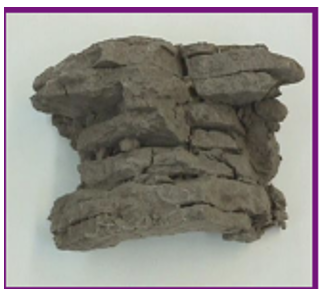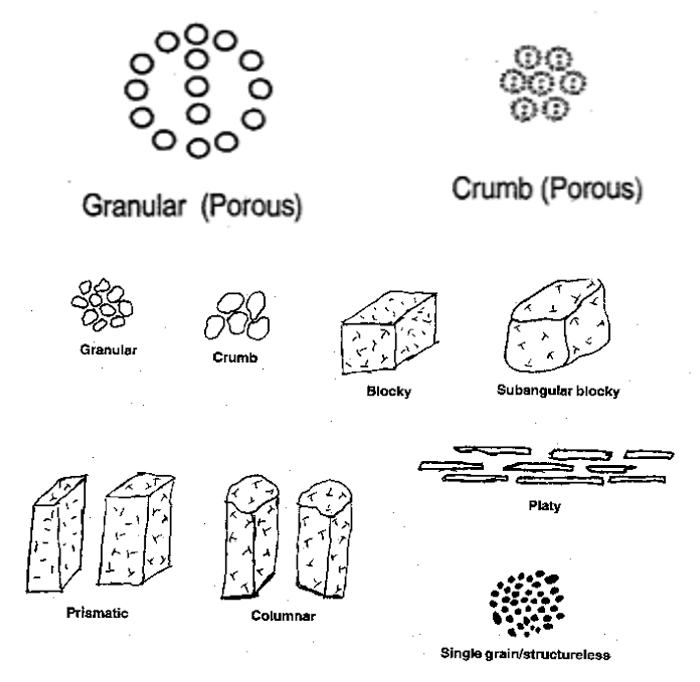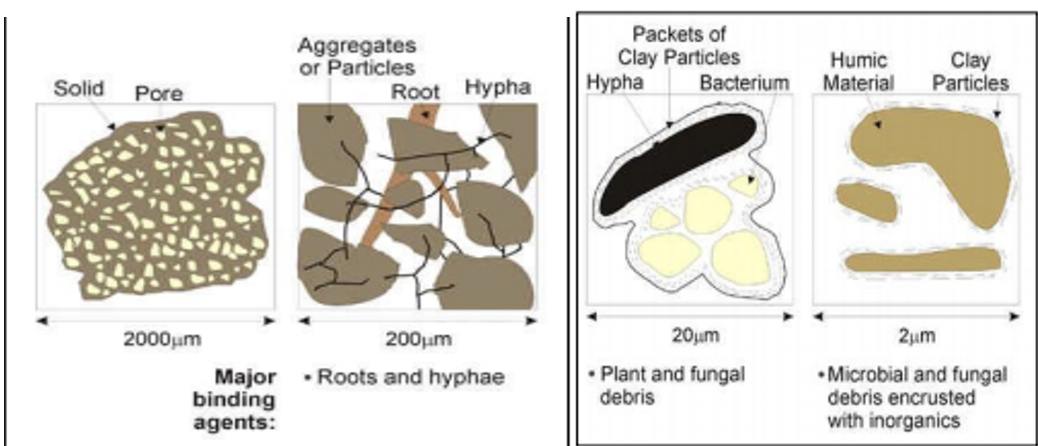🐾 Soil Structure
Structure Formation, Types, Naming, Importance, Soil Aggregates
- The primary soil particles viz. sand, silt and clay are usually grouped together in the form of aggregates.
The arrangement of primary soil particles and their aggregates (secondary particles) into certain defined patterns is called soil structure.
- Individual aggregates are known as peds or secondary units. Soils that do not have aggregates with naturally preserved boundaries of peds are considered to be structureless.
- Large masses of soil aggregates are called ‘clods’.
- Two forms of structure less conditions are recognized
- Single grain: Particles, are easily distinguished. Particles are unattached to each other and each particle acts individually. Movement of the air and capillary water is highest. Such structure is usually found in sandy soil and upper surface of podsols.
- Massive: Individual particles adhere closely to each other but the mass lacks planes of weakness. When clayey Soils are ploughed under wet condition, its individual particles adhere closely to each other and soil becomes massive or puddled. Such puddled soil retains water due to lack of pore spaces and thus is suitable for paddy.
- Soil conditions and characteristics such as water movement, heat transfer, aeration, bulk density, amount and size of pore space (porosity), availability of plant nutrients and growth of microorganisms are much influenced by soil structure. In fact, the important physical changes imposed by the farmer i.e. ploughing, cultivating, drainage, liming and manuring his land are structural rather than textural.
Soil Structure Formation
- The aggregate formation is influenced by the amount and nature of colloidal clay. The nature of adsorbed cations also influences it. Ca++ and H+ bring about better aggregation than Mg2+ and K+. Wetting of clay particles with a liquid like water is required to form aggregates because water molecules show dipole movement.
- Sesquioxides i.e. iron and aluminium oxides, act as cementing agents for binding sand and silt particles to form aggregates.
- Aggregates formed with sesquioxides are more stable than those formed by silicate clays. Colloidal organic matter is more effective, in forming aggregates than clay.
Colloidal clay
- By virtue of high surface area and surface charge, clay particles play a key role in the formation of soil aggregates.
- Sand and silt particles cannot form aggregates as they do not possess the power of adhesion and cohesion. These particles usually carry a coating of clay particles; they are enmeshed in the aggregates formed by the adhering clay particles.
- Colloidal particles form aggregates only when they are flocculated. There is vast difference between flocculation and aggregation. Flocculation is brought about by coalescence of colloidal particles and is the first step in aggregation.
- Aggregation is something more than flocculation involving a combination of different factors such as hydration, pressure, dehydration etc. and required cementation of flocculated particles. The cementation may be caused by cations, oxides of Fe and Al, humus substances and products of microbial excretion and synthesis. Clay particles form aggregates only if they are wetted by a liquid like water whose molecules possess an appreciable dipole moment.

- The aggregation also depends upon the nature of clay particles, size and amount of clay particles, dehydration of clay particles, cations like calcium and anions like phosphate.
- Fe and Al oxides
- The colloidal Fe oxides act as cementing agent in aggregation.
- Al oxides bind the sand and silt particles. These act in two ways.
- A part of the hydroxides acts as a flocculating agent and the rest as a cementing agent.
- Organic Matter
- It also plays an important role in forming soil aggregates.
- During decomposition, cellulosic substances produce a sticky material very much resembling mucus or mucilage. The sticky properly may be due to the presence of humic or humic acid or related compounds produced.
- Certain polysaccharides formed during decomposition.
- Some fungi and bacteria have cementing effect probably due to the presence of slimes and gums on the surface of the living organisms produced as a result of the microbial activity.
Types of Structure
- It refers to shape and arrangements of aggregates. Soil particles differ in size, shape and orientation. In general three broad categories of soil structure are recognised viz. Single grained, Massive and Aggregated.
- Between single grain and massive two extremes, an intermediate condition in which the soil particles are associated in quasi-stable small, clods are known as aggregates or peds.
- There are
fourprincipal forms of soil structure
Plate-like (Platy)
- In this type, the aggregates are arranged in relatively thin horizontal plates or leaflets. The horizontal axis or dimensions are larger than the vertical axis.
- When the units/ layers are
thickthey are called platy. - When they are
thinthen it is laminar.
- When the units/ layers are
- Platy structure is most noticeable in the surface layers of virgin soils but may be present in the sub soil horizon i.e. ‘B’. This type is inherited from the parent material, especially by the action of water or ice.

Prism-like
- The vertical axis is more developed than horizontal, giving a pillar like shape. Vary in length from 1 - 10 cm commonly occur in sub soil horizons (B) of Arid and Semi-arid regions.
- When the tops are rounded, the structure is termed as
columnarwhen the tops are flat / plane, level and clear cut -prismatic. - Columnar
- The peds are similar to prisms and are bounded by flat or slightly rounded vertical faces.

Block like
- All three dimensions are about the same size. The aggregates have been reduced to blocks. Irregularly six faced with their three dimensions more or less equal.
- When the faces are flat and distinct and the edges are sharp angular, the structure is named as
angular blocky. - When the faces and edges are mainly rounded it is called
sub angular blocky. - These types usually are common in heavy sub soils particularly of humid regions and in upper part of ‘B’ horizon.

Spheroidal (Sphere like)
- All rounded aggregates (peds) may be placed in this category.
- Not exceeding more than 2 cm in diameter (generally) often found in a loose condition in the ‘A’ horizon.
- The aggregates of this group are usually termed as
granularwhich are relatively less porous. - When the granules are very porous, it is termed as
crumb. This is specific to surface soil particularly high in organic matter/ grass land soils. - For the farmers, crumb and granular structure is favourable for plant growth.
- Formation of crumbs is more pronounced in clayey than in sandy soils. Clay humus and lime in the soil promote the formation of crumbs.


- The shapes, sizes and densities of aggregates generally vary within the profile.
- The aggregates of B-horizon are bigger due to weight of the top layers & less shrinkage and expansion activity as there are less fluctuations of soil moisture.
- The profile in semi-arid region contain granulated A-horizon with a prismatic B-horizon. In humid temperate regions, the A-horizon contains granulated aggregates but B-horizons have platy or blocky aggregates.
Classes of Structure
- Each primary structural type of soil is differentiated into 5 size classes depending upon the size of the individual peds.
- The terms commonly used for the size classes are
- Very fine or very thin
- Fine or thin
- Medium
- Coarse or thick
- Very Coarse or very thick
- The terms thin and thick are used for platy types, while the terms fine and coarse are used for other structural types.
Grades of Structure
- Grades indicate the degree of distinctness of the individual peds. It is determined by the stability of the aggregates. Grade of structure is influenced by the moisture content of the soil. Grade also depends on organic matter, texture etc. Four terms commonly used to describe the grade of soil structure are:
- Structureless: There is no noticeable aggregation, such as conditions exhibited by loose sand. (single grain & massive)
- Weak Structure: Poorly formed, indistinct formation of peds, which are not durable and much un-aggregated material.
- Moderate structure: Moderately well-developed peds, which are fairly durable and distinct.
- Strong structure: Very well formed peds, which are quite durable and distinct.
Structure naming
- For naming a soil structure the sequence followed is grade, class and type; for example strong coarse angular blocky, moderate thin platy, weak fine prismatic.
Factors Affecting Soil Structure
👉🏻 The development of structure in arable soil depends on the following factors:
- Climate
- Climate has considerable influence on the degree of aggregation as well as on the type of structure. In arid regions there is very little aggregation of primary particles. In semi-arid regions, the degree of aggregation is greater.
- Organic matter
- Binding effect, water holding, porosity is increased by adding O.M. to soil. Cementing action of humus is equivalent to certain inorganic compounds like oxides of Fe which provide most of the long-term aggregate stability.
- Polyvalent inorganic cations e.g. Ba2+, Ca2+, Mg2+ and Al3+ cause, flocculation which act as bridges between O.M. and soil clays. There is only one practical way to improve the soil structure is to add O.M. to the soil.
- Tillage
- Cultivation implements break down the large clods into smaller fragments and aggregates. For obtaining good granular and crumby structure, optimum moisture content in the soil is necessary. If the moisture content is too high it will form large clods on drying. If it is too low some of the existing aggregates will be broken down.
- Plants, Roots and Residues
- Excretion of gelatinous organic compounds and exudates from roots serve as a link Root hairs make soil particles to cling together.
- Animals
- Among the soil fauna small animals like earthworms, moles and insects etc., that burrow in the soil are the chief agents that take part in the aggregation of finer particles.
- Microbes
- Algae, fungi, actinomycetes and fungi keep the soil particles together. Fungi and actinomycetes exert mechanical binding by mycelia, Cementation by the products of decomposition and materials synthesized by bacteria.
- Fertilizers
- Fertilizer like Sodium Nitrate destroys granulation by reducing the stability of aggregates. Few fertilizers for example, CAN help in development of good structures.
- Wetting and Drying
- When a dry soil is wetted, the soil colloids swell on absorbing water. On drying, shrinkage produces strains in the soil mass gives rise to cracks, which break it up into clods and granules of various sizes.
- Adsorbed Cations
- Na+ and K+ ions disperse the soil, while Ca2+, Ba2+ have favourable effects on the aggregation. Similarly the presence of soluble salts favour flocculation.
- Inorganic cements
- CaCO3 and Sesquioxides
- Clay
- Water
Effect of Soil Structure on other Physical Properties
- Porosity: Porosity of a soil is easily changed. In plate like structure, pore spaces are less where as in crumby structure pore spaces are more.
- Temperature: Crumby structure provides good aeration and percolation of water in the soil. Thus these characteristics help in keeping optimum temperature in comparison to plate like structure.
- Density: Bulk density varies with the total pore space present in the soil. Structure chiefly influences pore spaces. Platy structure with less total pore spaces has high bulk density whereas crumby structure with more total pore spaces has low bulk density.
- Consistence: Consistence of soil also depends on structure. Plate-like structure exhibits strong plasticity.
- Colour: Bluish and greenish colors of soil are generally due to poor drainage of soil. Platy structure normally hinders free drainage.
Importance of Structure
- Soil structure influences rather indirectly by the formation of an array of pores of various shapes and sizes. These pores are controlling factors governing water, air and temperature in soil.
- The role of soil structure in relation to plant growth
- Soil structure influences the amount and nature of porosity.
- Structure controls the amount of water and air present in the soil. Not only the amount of water and air dependent on soil structure, but their movement and circulation are also controlled by soil structure.
- It affects tillage practices.
- Structure controls runoff and erosion.
- Platy structure normally hinders free drainage whereas sphere like structure (granular and crumby) helps in drainage.
- Crumby and granular structure provides optimum infiltration, water holding capacity, aeration and drainage. It also provides good habitat for microorganisms and supply of nutrients.
Soil aggregates
- Soil aggregates are “clumps” of soil particles that are held together by moist clay, organic matter (such as roots), by organic compounds (from bacteria and fungi) and by fungal hyphae (pronounced “highfee”). Aggregates vary in size from about 2 thousandths of a millimetre across up to about 2 millimetres across, and are made up of particles of varying sizes.
- Some of these particles fit closely together and some do not and this creates spaces of many different sizes in the soil. These spaces, or pores, within and between soil aggregates are essential for storing air and water, microbes, nutrients and organic matter. Soils with many aggregates are called “well-aggregated”. Such soils are more stable and less susceptible to erosion.
- There are two ways that bacteria could be involved in soil aggregation. One way is by producing organic compounds called polysaccharides. Bacterial polysaccharides are more stable than plant polysaccharides, resisting decomposition long enough to be involved in holding soil particles together in aggregates. The other way bacteria are involved in soil aggregation is by developing a small electrostatic charge that attracts the electrostatic charge on clay surfaces, bringing together small aggregates of soil.

- Fungi grow in long, threadlike structures, called
hyphae. The amount of aggregation in the soil has been found to relate to the length of fungal hyphae in the soil. Fungi help to form aggregates in the soil by enmeshing soil particles with their hyphae and forming crosslinks between soil particles. Mycorrhizal fungi and fungi that colonise fresh organic matter are believed to be the most important for assisting with stabilisation of soil particles into aggregates.
Significance of soil aggregation
- Crop growth is often constrained by poor root development, by slow water infiltration and water movement through the soil, and by poor soil aeration. These constraints are often associated with poor soil porosity. Soil aggregation is important to developing and maintaining good soil porosity and hence to good root growth and to movement of soil water and gases. With more soil in water stable aggregates, it is expected that:
- The rate of water infiltration and percolation will increase
- Soil crusting will be less – which improved root penetration and access to soil moisture and nutrients and emergence of seedlings
- Resistance to the splash effect of raindrops will increase and soil erodibility will decrease; and
- Runoff will decrease, making more water available to the crop.
- The importance of soil physical properties to crop growth, including soil aggregation properties, is often under-estimated by producers, and practical exercises can be useful in conveying information on the importance of these properties.
- The primary soil particles viz. sand, silt and clay are usually grouped together in the form of aggregates.
The arrangement of primary soil particles and their aggregates (secondary particles) into certain defined patterns is called soil structure.
- Individual aggregates are known as peds or secondary units. Soils that do not have aggregates with naturally preserved boundaries of peds are considered to be structureless.
- Large masses of soil aggregates are called ‘clods’.
- Two forms of structure less conditions are recognized
- Single grain: Particles, are easily distinguished. Particles are unattached to each other and each particle acts individually. Movement of the air and capillary water is highest. Such structure is usually found in sandy soil and upper surface of podsols.
- Massive: …
Become Successful With AgriDots
Learn the essential skills for getting a seat in the Exam with
🦄 You are a pro member!
Only use this page if purchasing a gift or enterprise account
Plan
Rs
- Unlimited access to PRO courses
- Quizzes with hand-picked meme prizes
- Invite to private Discord chat
- Free Sticker emailed
Lifetime
Rs
1,499
once
- All PRO-tier benefits
- Single payment, lifetime access
- 4,200 bonus xp points
- Next Level
T-shirt shipped worldwide

Yo! You just found a 20% discount using 👉 EASTEREGG

High-quality fitted cotton shirt produced by Next Level Apparel